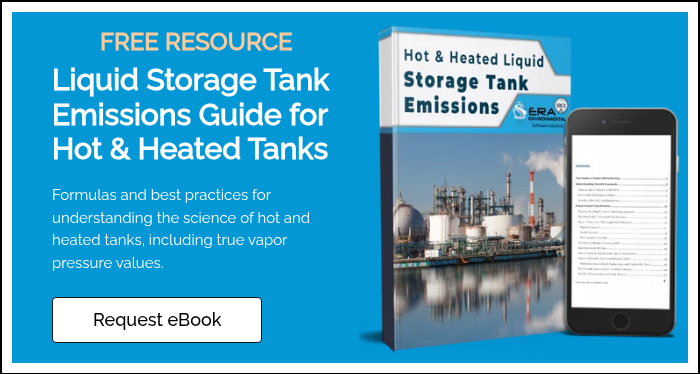One of the biggest challenges for any site that uses tanks – including chemical manufacturers and companies in the Oil & Gas industry – is the calculation and accurate determination of emissions originating from hot and heated liquid storage tanks.
Back in 2015, for example, the EPA's TANKS 4.09D software, which handled most operating scenarios and tank types well, was revealed to be inadequate at estimating emissions from hot and heated tanks. Likewise, its replacement, TANKS 5.1 (released October 2024) does not offer a specific calculation functionality for these tanks. That means any business that uses tanks to store heated products slowly cooling down or to keep a product at a certain fixed temperature must find an alternate means of tracking and reporting air emissions from tanks.
This blog presents an overview on how to calculate emissions from hot and heated storage tanks, whether the tank is semi-insulated and experiences breathing losses or not, and offers five best practices to follow when preparing and reporting these emissions.
For a more detailed explanation of tanks emissions calculations for hot and heated tanks, please request our free eBook on our website.
How to Calculate Emissions for Hot and Heated Tanks
The underlying logic at work when calculating air emissions for any type of tank is that the tank's total losses equal the standing storage losses (due to evaporation) plus any working losses (from forced expelling when the tank is being filled with liquid).
Total losses (Lt) = Working losses (Lw) + Standing losses (Ls)
Given that a hot or heated tank is characterized by its being insulated, the standing losses can be thought of as any breathing losses that occur as a result of heating cycles and/or poor insulation. By referencing the AP-42 Chapter 7 guidelines, notably the section on working and breathing losses for hot and heated tanks, we can modify the base equation to look like this:
Lt = (0.0010 x Mv x Pva x Q x Kn x Kp) + (365 x Wv x Vv x Ke x Ks)
Where:
- Mv is the molecular weight of vapor
- A value of 150 can be assumed only in situations where determining the molecular weight of one or more of the liquid's chemical components is not possible
- Pva is the vapor pressure at stored liquid temperature
- Refer to our eBook for instructions on calculating vapor pressure for organic chemical mixtures, petroleum products, and crude oil
- Q is the amount of liquid processed
- Kn is the working loss turnover factor
- Kp is the product factor for the specific liquid
- 365 represents the total number of days in the year (constant except in leap years)
- Wv is the vapor density in lb/ft cubed
- Vv is the vapor space volume in ft cubed
- Ke is the vapor space expansion factor (dimensionless)
- Ks is the vented vapor saturation factor (dimensionless)
Before applying this equation, you will have to calculate the unique values for each of the basic variables for each of your tanks—the tank's parameters and physical properties, the chemical makeup of the liquid, the atmospheric conditions of the tank's locations, the amount of liquid moving through the tank, and the liquid's standing time.
Keeping track of that many variables, some of which come with their own set of lengthy formulas, requires a great deal of daily tracking and careful recordkeeping. This degree of data management is why many managers of hot and heated tanks are turning to sophisticated storage tank emissions calculation software like ERA's.
Best Practices for Hot and Heated Storage Tank Emissions Calculations
As mentioned above, calculating emissions from any kind of tank is not as easy as plugging in default values or one-time meter readings into a formula. There is a lot of preliminary and processing work that goes into each calculation, meaning there are multiple possibilities for wrong turns along the way.
The following are five recommendations gathered from years of experience in tank emissions calculation assistance; keep them in mind the next time you're preparing your emission reports.
Follow AP-42 Chapter 7 guidelines
First and foremost, the most important rule is to stick to the AP-42 Chapter 7 guidelines, the gold standard for tank emissions. No matter what the situation, there are AP-42 emission calculations that can be applied. Among the over 30 different calculations in the chapter, there is one that outlines the base equation for estimating emissions from hot and heated tanks (as shown above).
The general rule is that hot and heated tanks remain at a stable temperature and so there should be little to no tank breathing losses taking place. They primarily generate working losses. However, TCEQ research suggests hot and heated tanks all emit some amount of breathing losses, and while a well-insulated tank will produce only a small amount, a poorly-insulated tank will produce significant breathing losses.
AP-42 equations are not necessarily the most complex an EH&S manager will encounter in their careers, but the AP-42 Chapter 7 procedure can become quite time-consuming when performed manually for numerous tanks, requiring meticulously accurate recordkeeping at a large scale.
Do Not Use AP-42 Default Values
In sharp contrast to the previous best practice, we recommend not using AP-42 default values for vapor pressure or liquid composition. The TCEQ has even urged reporters to avoid them unless they've done the calculations to verify these values accurately represent the materials in their tanks.
This is not to say that AP-42 default values are not accurate or acceptable in some cases, but rather that determining chemical properties for your specific case will yield more accurate results.
Use Vapor Pressure Values Based on Real-World Storage Temperature in Your Tank
Determining the True Vapor Pressure (TVP) of any material in a hot or heated tank can be a challenge, but it is imperative that you use only accurate TVP values when performing AP-42 calculations.
That’s no small feat for some materials, like asphalt, for which the complete chemical composition of each batch cannot be fully known. Nonetheless, the TCEQ directs all petrochemical manufacturers to use the best available methodology to determine an accurate TVP value based on the temperature of the product in the tank.
ERA has already written about the topics of True Vapor Pressure and tank emissions elsewhere on this blog, so we’ll just provide a recap here:
- The best idea is to go straight to the source and get TVP data from your supplier. Obviously this isn’t always possible, but getting a TVP value from your supplier will save you a lot of time and effort.
- If your supplier can’t provide TVP data, the next step is to use either the Riedel or Antoine coefficients (below) combined with known product chemical data.
Follow the American Society for Testing and Materials Method for TVP
For heavy liquids in storage tanks, it is possible to use the American Society for Testing and Materials (ASTM) method D2879 to determine TVP for heavy liquids stored at a particular temperature.
ATSM also provides other methodologies for determining TVP based on material type (i.e. crude oils, petroleum products, pure liquids, etc.).
Like other resources, there is a small price to purchase access to the ASTM’s intellectual property. You can find the resources for D2879 (and others methods) here: http://www.astm.org/Standards/D2879.htm.
Stop Using Spreadsheets for Tank Emission Determinations
This recommendation goes out to both people who use spreadsheets to store their tank parameter and chemical data and to those who rely on spreadsheet formulas to perform tank emission calculations.
Spreadsheets, even when built by professionals, don’t have the capacity or intelligence to be a sustainable tool.
There are numerous other reliable tools that are specifically designed to handle hot & heated tank calculations. The key is to find tanks emissions software that offers functionality for all your types of tanks and processes rather than just focusing on one type of material (e.g. crude oil) or one type of emission (e.g. flashing losses).
ERA has also prepared a free downloadable guide on tank emissions calculations for hot and heated tanks that complements the information in this article. It delves into more advanced techniques for managing petroleum products like asphalt and crude oil, as well as the procedures you should follow to determine TVP and partial speciation.
An earlier version of this blog was originally written by Alex Chamberlain.
This Blog was Co-Authored By:


Tags:
Air Management
April 1, 2025

Comments